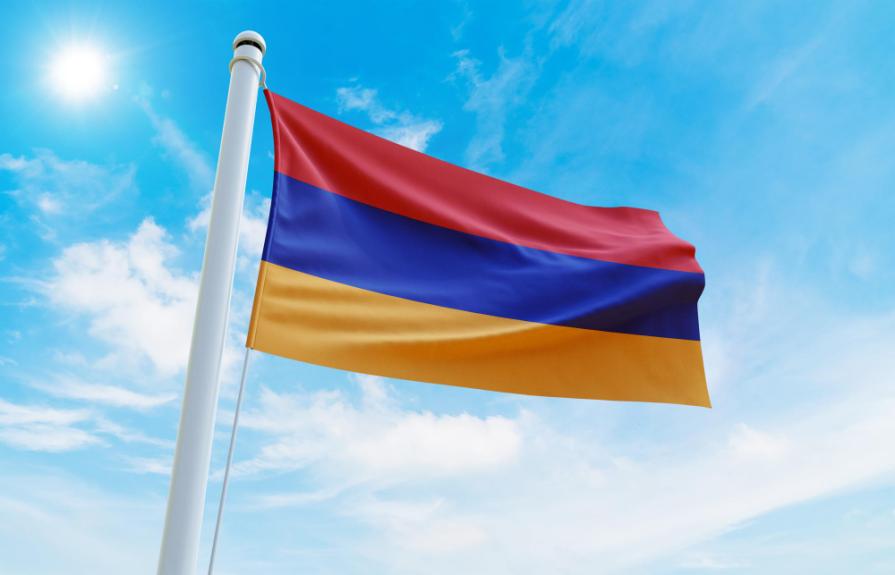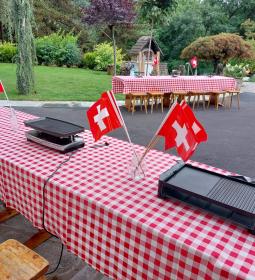It is believed that the first flag of the Armenian state was the dynastic prapor of the Mamikoyanid family: an eagle with two heads, holding in its paws either an animal (a ram, a sheep or something else), or a weapon - a bow.
Such a description is contained in the work of the Armenian historian of the V century AD It is noted that the color of the flag is red, and the bird on it, according to Persian sources, was gold or brown. With a high degree of probability, however, these drawings, which adorn the churches of the villages and villages of Armenia in abundance, were created for purely decorative purposes.
Cilician Armenia – the second Armenian state located before the invasion of the Seljuk Turks in the area of Alexandretta, Tarsus and Antioch – also had its own symbols. According to the descriptions of contemporaries, it was about purple flags with gold or silver crosses, although the reliability of this information remains in doubt.
The old Armenian dynasty was replaced by the Lusignan family, a branch of the French noble family, which also ruled in Cyprus and Palestine (The Guy de Lusignan was the spouse of Queen Sibylla, the sister of the last king of the Iron Dynasty). Their colors were white – belonging to the house, red, blue and yellow.
The Armenian diaspora, especially the French diaspora,was actively engaged in the process of national revival after the loss of the ethnic home of the Armenian people. For example, during the farewell to the great French writer Victor Hugo, a red-green-blue (according to another version - white) flag was used, which, according to its creator, priest Leon Alishan, is a symbol of the rainbow seen by Noah on the top of Mount Ararat.

The same holy father wrote that in the calendar of the Armenian Church the first Easter Sunday is called red, and the second - green; white connects all the other colors of the rainbow spectrum.
Armenia under Russian rule
Three centuries of Muslim domination of the Persians and Turks ended in 1829, when, according to the Treaty of Turkmanchay, the Erivan Khanate went to Russia, as part of which the Armenian region was formed. She had no flag, only the coat of arms, approved in February 1933.
A new stage in vexillology is the revolution, first in February and then in October. In May 1918, after the collapse of the Transcaucasian Sejm, which was trying to create a democratic federation, the Armenian Republic was formed under the control of the Menshevik-Dashnak party "Dashnaktsutyun". Unfortunately, the Armenians failed to hold the territory, as a result of the offensive of the Turkish troops, they managed to hold only two counties - Erivan and Echmiadzin. The rest of the country was captured by bandits under the flag of Islam. They were expelled only after the Armistice of Mudros, when the Turks were replaced by the British and French. The occupation of the Entente made it possible first to create a pro-Turkish government of the South-West Caucasian Democratic Republic, uniting Kurds and Armenians, on the former territory of Turkish Armenia, and then to merge this government together with the controlled regions into Armenia.
The National Council – the Parliament – considered the issue of the national flag, eventually adopting red-blue-orange colors. At the constituent assembly, it was planned to approve this set by a constitution or law, but it never came to the convocation - the civil war and the establishment of the Armenian revolutionary committee in November 1920 with the subsequent establishment of the Soviet Socialist Republic of Armenia prevented it.

The constitution of the new state was adopted by the First Armenian Congress of Soviets on February 2, 1922, it also approved the first description of the state flag - red with a gold inscription with the name of the state (variant - the abbreviation of the SSRA) in Armenian.
Less than a month later, the three Transcaucasian republics (plus Abkhazia) were united under the brand of the Transcaucasian Federation – and the latter, along with the RSFSR, Ukraine and Belarus, became the founder of the Soviet Union. The association has not abolished the formal status of independent Armenia. In 1927, a constitution was adopted, which also contained a description of the flag in its 106th article: a scarlet cloth with gold S.S.R.A. letters in the upper left corner, near the pole itself. In Russian or Armenian language is not specified.
Ten years later, Stalin decided to reorganize the USSR. The TSFSR was abolished, and Armenia became the Armenian SSR, directly part of the Union. In the new constitution, the flag was described in Article 122 as an unchanged color cloth with a sickle, hammer and abbreviation in Armenian, with proportions of 1: 2. From the interesting: the order of the words "socialist" and "Soviet" has changed, in Russian starting the same way, and in Armenian - with different letters of the alphabet. In the 40s, the authorities for several years could not decide how to correctly spell "republic", and several times made modifications to the text of the basic law.
The next page was opened in December 1952, when by the decision of the Presidium of the Armed Forces of Armenia, a red canvas with a blue horizontal stripe of 1/4 of the flag in full length was approved by the flag. The kryzh has the same sickle, hammer and red star with a gold border. The proportions have not changed.

The heraldic significance of the flowers was not revealed, but the intelligentsia usually linked blue with the rivers of the country and Lake Sevan.
The Constitution-1978 retained the former appearance of the banner.
The Path to Independence and Dreams of Beauty
In the summer of 1990, against the background of ethnic processes in Karabakh and millions of rallies in Yerevan, a law was adopted that approved the old-new flag of 1919, however, with a ratio of 2: 1 instead of 3: 2.
In 1999, an article appeared on the website of Rafik Kozhayan with a proposal to make the flag of the country more original and abandon the usual layout. The idea implied the separation of wide colored stripes with narrow whites, which, firstly, was designed to symbolize the peaks of Ararat, and secondly, demonstrated solidarity with Nagorno-Karabakh, on the flag of which white was present in the form of a traditional ethnic pattern.
Another beautiful option was developed by the artist Mikol Ka kayan - on the traditional tricolor he added an equilateral cross, and placed Ararat, Noah's Ark and the sun with a rainbow in the middle. There was a proposal to completely replace the existing flag with a rainbow seven-colored one, but the terrorist attack in the Armenian parliament once reduced the discussion to "no".











